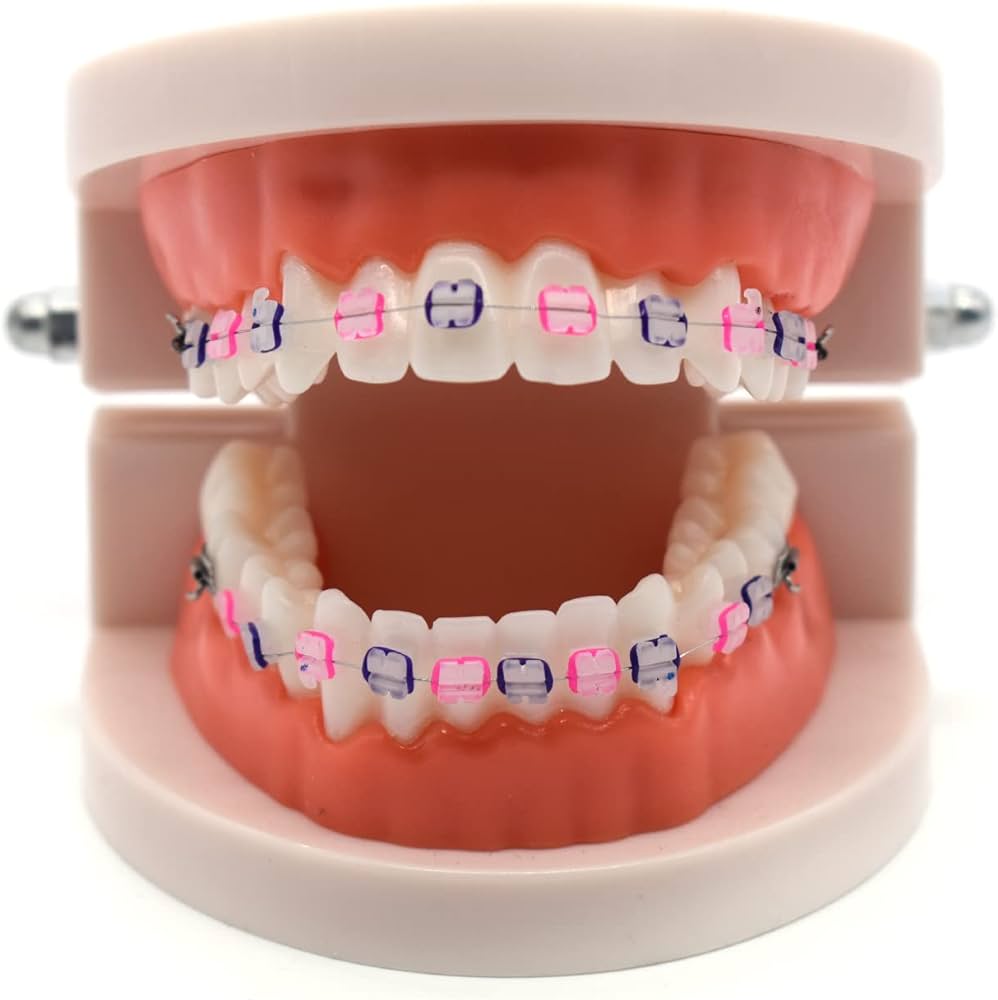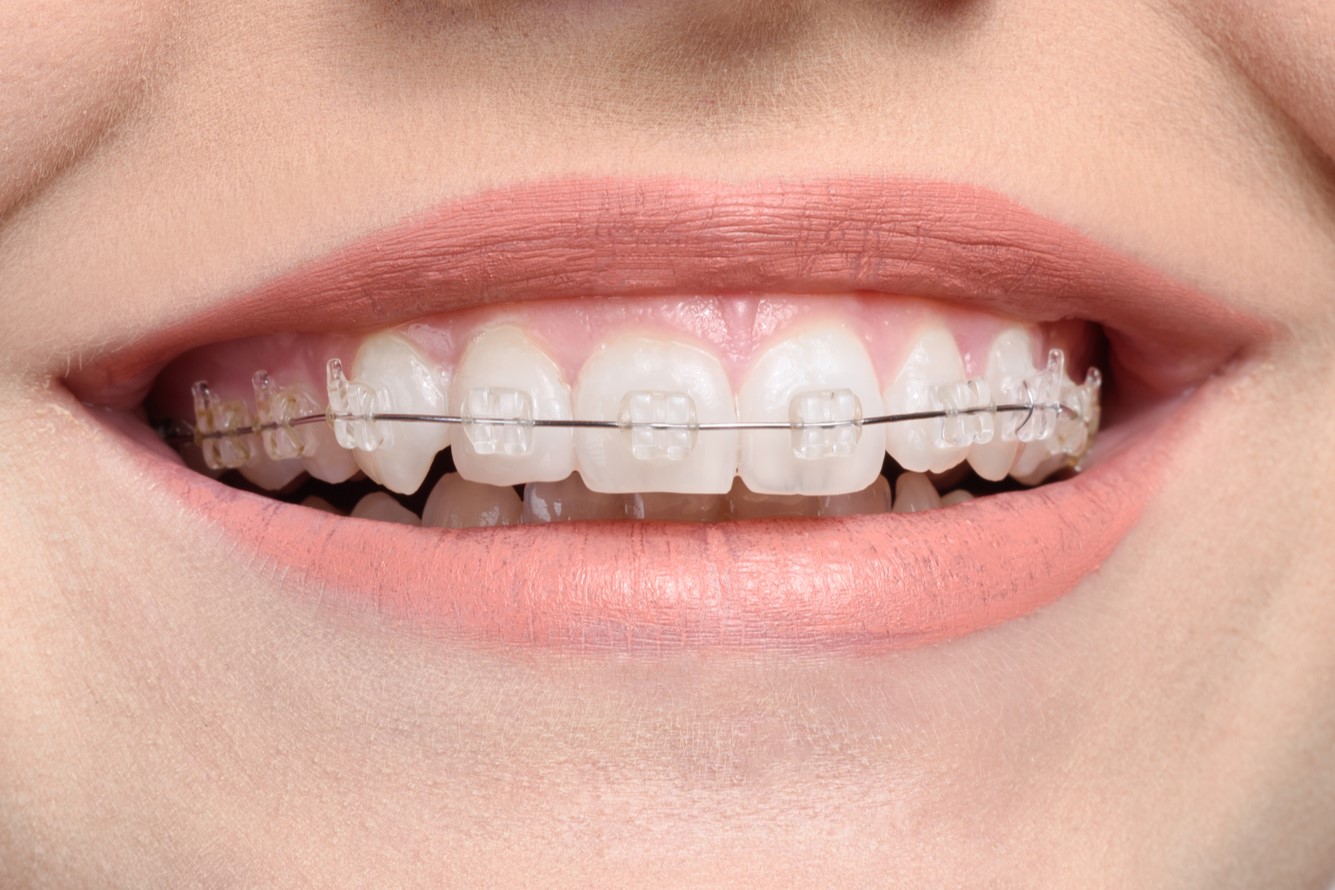Ceramic dental braces have revolutionized orthodontic treatment, offering patients a discreet and effective alternative to traditional metal oral braces. These braces, often referred to as transparent teeth braces or tooth-colored braces, have gained popularity for their ability to blend seamlessly with the natural color of teeth while still delivering exceptional results in aligning teeth and correcting bites. In this article, we delve into the intricacies of braces with ceramic brackets, exploring their advantages and why they are increasingly becoming the preferred choice for many orthodontic patients. We shall also discuss upon ceramic braces cost in Kerala and their disadvantages also.
Introduction to Braces with Ceramic brackets
Ceramic braces are a popular option in cosmetic dentistry for those seeking a more discreet way to straighten their teeth. Ceramic braces are crafted from transparent or tooth-colored materials, making them significantly less conspicuous than their metal counterparts. Braces with ceramic brackets consist of clear or tooth-colored brackets that are affixed to the teeth and connected by wires and elastic bands. While they function similarly to traditional metal oral braces, their aesthetic appeal sets them apart, offering a more discreet orthodontic solution for individuals who may feel self-conscious about wearing braces.
The Advantages of Braces with Ceramic brackets
Aesthetic Appeal
One of the primary advantages of braces with ceramic brackets is their ability to blend seamlessly with the natural color of teeth. Unlike metal oral braces, which can be visually prominent, transparent teeth braces offer a more subtle and aesthetically pleasing alternative, making them particularly popular among adult patients and image-conscious teenagers. While ceramic braces are not entirely invisible, their subtle appearance makes them significantly less noticeable than metal braces, particularly from a distance or in photographs.
Comfort and Durability
Despite their delicate appearance, ceramic braces are durable and can withstand the forces involved in orthodontic treatment. Additionally, they are designed to be smooth and comfortable, minimizing irritation to the cheeks and gums commonly associated with traditional oral braces.
Effective and Comfortable Treatment
Braces with ceramic brackets are highly effective in correcting a wide range of orthodontic issues, including crooked teeth, overcrowding, gaps, and malocclusions. They offer the same level of precision and control as metal braces, ensuring optimal results for patients seeking to achieve a straighter and healthier smile. Ceramic braces utilize advanced low friction technology, which reduces the amount of force required to move teeth. This results in a more comfortable treatment experience and may lead to faster treatment times compared to traditional braces.
Stain-Resistant Properties
Modern ceramic materials are designed to resist staining, allowing patients to maintain a bright and natural-looking smile throughout their orthodontic treatment. This is particularly advantageous for individuals who enjoy consuming dark-colored beverages or foods that may otherwise discolor traditional braces.
Customization Options
Ceramic braces offer customization options, allowing patients to choose from various shades of ceramic brackets to best match their natural tooth color. This customization ensures that the braces blend seamlessly with the patient’s smile, further enhancing their aesthetic appeal. Patients can also personalize their braces by selecting different shapes and sizes of ceramic brackets to better fit their dental structure. Additionally, they can opt for colored or clear ties and bands, allowing them to express their unique style while undergoing orthodontic treatment.

Disadvantages of Braces with Ceramic brackets
While braces with ceramic brackets offer numerous advantages, they are not without their drawbacks. It’s important for patients to consider both the pros and cons before deciding on their orthodontic treatment. Here are some potential disadvantages of ceramic braces:
Cost
Ceramic braces tend to be more expensive than traditional metal braces. The materials used in ceramic braces are typically pricier, and the manufacturing process may also contribute to the higher cost. For patients on a tight budget, the expense of ceramic braces may be prohibitive. Ceramic braces cost in Kerala shall be discussed in detail towards the end of this article.
Discomfort and Durability Concerns
While ceramic braces are designed to be smooth and comfortable, some patients may experience discomfort or irritation, particularly during the initial adjustment period. The brackets and wires of ceramic braces may rub against the cheeks or lips, causing soreness or ulcers. However, this discomfort typically diminishes as the mouth adapts to the presence of the braces. While ceramic braces are durable, they may not be as robust as metal braces. The ceramic material used in the brackets can be prone to chipping or cracking, especially if subjected to excessive force or impact. Patients need to be cautious about biting into hard or sticky foods that could potentially damage their ceramic braces.
Staining Potential
Despite advancements in ceramic technology, there is still a risk of staining with ceramic braces. While the brackets themselves are designed to resist staining, the elastic bands used to hold the wires in place may discolor over time, particularly if patients consume foods or beverages known to stain teeth, such as coffee, tea, or red wine. Proper oral hygiene practices, including regular brushing and flossing, can help minimize staining, but it remains a concern for some patients.
Treatment Time
In some cases, treatment with ceramic braces may take longer compared to treatment with traditional metal oral braces. Braces with ceramic brackets exert less force on the teeth than metal braces, which can result in slower tooth movement and extended treatment times. Additionally, ceramic braces may require more frequent adjustments by the orthodontist to maintain progress, further prolonging the overall treatment duration.
Risk of Allergic Reaction
While rare, some patients may have an allergic reaction to the materials used in ceramic braces. Ceramic braces typically contain metal components, such as nickel or chromium, which can trigger allergic responses in sensitive individuals. Patients with known metal allergies should discuss their concerns with their orthodontist before opting for braces with ceramic brackets.
Ceramic braces cost in Kerala
The cost of ceramic braces in Kerala can vary widely depending on several factors, including the complexity of the dental issue, the specific orthodontist’s experience, and the location of the clinic. On average, patients can expect to pay between INR 30,000 to INR 80,000 for a complete treatment with ceramic braces. This price range may also be influenced by additional services such as consultations, follow-up visits, and any necessary adjustments during the treatment period. While ceramic braces tend to be more expensive than traditional metal braces due to their aesthetic advantages and materials used, many patients in Kerala find the extra cost worthwhile. This is because ceramic braces offer a discreet and customizable treatment option. It’s advisable for patients to consult with their dentist to get a detailed quote and understand the payment plans available.
Conclusion
Ceramic braces offer a winning combination of aesthetics, comfort, and effectiveness, making them an attractive option for individuals seeking orthodontic treatment. With their discreet appearance and impressive results, ceramic braces empower patients to embrace the journey to a straighter and healthier smile with confidence. Choosing ceramic braces involves carefully weighing various factors to make an informed decision. Patients must consider the aesthetic benefits, such as their ability to blend seamlessly with natural teeth and offer customization options. These benefits should be weighed against the higher cost compared to traditional metal braces. It is essential for patients to evaluate their budget, the severity of their orthodontic needs, and the desired outcome. Ultimately, the decision should balance aesthetic preferences, financial considerations, and the specific orthodontic requirements of the patient.

